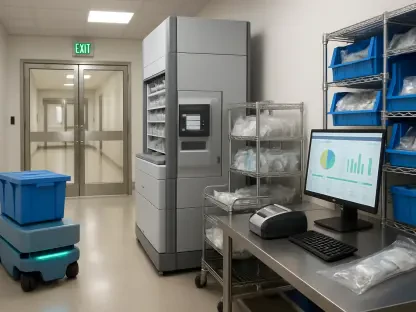Healthcare revenue cycle management has always been a complex and multifaceted process. With evolving payer requirements, increasing denial rates, and significant workforce shortages, the need for innovative and efficient solutions has never been more urgent. Artificial Intelligence (AI) and automation are emerging as critical tools to alleviate these challenges and revolutionize revenue cycle operations in the healthcare sector.
The Current Challenges in Healthcare Revenue Management
Payer Challenges and High Denial Rates
One of the predominant struggles in healthcare revenue cycle management is navigating payer challenges, which include high denial rates and complex prior authorization requirements. Nearly half of healthcare leaders report a net collection yield of 93% or less, underscoring the critical need for improvement. High denial rates, often exceeding 3.1%, create significant stress among healthcare executives. Payers’ stringent requirements and the intricacies involved in gaining prior authorizations add layers of complexity to the revenue cycle process. These issues result in increased costs due to additional labor needed for appeal activities and prolong payment cycles, impacting cash flow and financial stability.
For healthcare organizations, the intricacies of payer relations entail submitting detailed documentation, frequently responding to additional information requests, and managing a higher volume of denied claims. The time and resources diverted to these activities reduce the operational efficiency of revenue cycle management. Furthermore, the need to appeal and re-submit denied claims demands a significant amount of human labor, which is already strained by workforce shortages. Thus, the industry is in dire need of solutions that can streamline these processes, minimize denials, and enhance revenue collection to sustain financial health.
Workforce Shortages and Operational Difficulties
Labor shortages further exacerbate the challenges within revenue cycles. A staggering 90% of healthcare executives report facing considerable workforce shortages, making it difficult to manage the labor-intensive facets of revenue cycle management effectively. This shortage not only impacts day-to-day operations but also places a strain on the existing workforce, leading to burnout and decreased productivity. These workforce constraints mean that healthcare providers must find new ways to maintain efficiency and ensure timely reimbursements without solely relying on human labor. This is where AI and automation solutions become appealing alternatives.
The dual burden of high denial rates and workforce shortages creates a challenging environment for revenue cycle management. Lower staffing levels make it harder to handle the influx of denied claims, delays in prior authorizations, and additional documentation required by payers. Additionally, the pressure on existing staff can result in higher turnover rates, further destabilizing operations. Implementing technology like AI and automation becomes necessary to mitigate the strain on human resources, reduce errors, and optimize the workflow, allowing healthcare providers to navigate these challenges more effectively.
Strategic Responses: Outsourcing and Consulting
Leveraging Managed Services and External Partners
To combat workforce shortages and streamline operations, many healthcare systems are turning to outsourcing and consulting. Approximately 80% of healthcare executives currently utilize some form of revenue cycle outsourcing, and 71% express satisfaction with these partnerships. Managed services allow healthcare providers to supplement their in-house teams with external experts, who can handle payer negotiations and optimize revenue processes. Engaging with external partners provides crucial support in areas such as claim management, denial resolution, and patient access services. These partnerships help healthcare organizations navigate the complexities of payer processes more effectively, ultimately leading to improved revenue cycle performance.
By outsourcing specific revenue cycle functions to managed service providers, healthcare organizations can leverage specialized expertise and advanced technologies that might not be available internally. This strategy not only improves operational efficiency but also ensures compliance with ever-changing regulations and payer requirements. Managed services can implement standardized procedures and best practices, ensuring a more consistent and streamlined revenue cycle process. This collaborative approach helps healthcare providers focus on their core medical services, enhancing overall service delivery and patient care.
Satisfaction with Outsourced Solutions
The growing dependency on managed services reflects a broader trend toward collaborative solutions in healthcare. External partners can deliver specialized expertise and scalable resources, helping healthcare executives address operational bottlenecks and improve reimbursement rates. This satisfaction with outsourcing is indicative of its success in mitigating some of the most pressing challenges in revenue cycle management. Outsourcing partners bring the advantage of niche specialization, including in-depth knowledge of payer policies, sophisticated analytics, and robust denial management processes. These capabilities help healthcare organizations enhance their revenue cycle’s effectiveness and resilience.
Furthermore, managed services offer flexibility in staffing, allowing healthcare providers to scale up or down based on demand without the complexities of hiring and training new employees. This agility is particularly beneficial during peak periods or when implementing large-scale changes such as transitioning to new payer contracts or updating billing systems. The consistent performance metrics and accountability provided by managed services enable healthcare executives to make data-driven decisions, ultimately contributing to better revenue cycle outcomes and financial health.
The Role of Technology: AI and Automation
AI in Revenue Cycle Management
The integration of AI in healthcare revenue cycle promises to reduce human error, speed up processes, and increase accuracy. By automating routine tasks such as data entry and claim scrubbing, AI frees up human resources to focus on more complex tasks that require critical thinking and problem-solving skills. AI-driven tools can analyze vast amounts of data to identify patterns and predict outcomes, enabling proactive management of claims and reducing the likelihood of denials. This predictive capability aids in enhancing overall efficiency and ensuring that claims are processed swiftly and accurately.
In addition to improving accuracy, AI can also enhance decision-making processes within the revenue cycle. By utilizing machine learning algorithms, AI systems can provide insights into the most effective strategies for handling specific payer requirements and identifying the root causes of denied claims. These insights allow healthcare providers to implement targeted interventions and preventive measures, further minimizing the incidence of denials and optimizing revenue collection. Moreover, AI can assist in real-time monitoring and reporting, providing healthcare executives with up-to-date information on revenue cycle performance and enabling timely adjustments to workflows and strategies.
Automation as a Critical Solution
Automation is considered the second most critical strategy to address staffing challenges in the revenue cycle. By automating repetitive and time-consuming tasks, healthcare organizations can significantly reduce the burden on their workforce. Automation can handle tasks such as eligibility verification, prior authorization requests, and follow-up on unpaid claims, thus speeding up the entire revenue cycle process. Moreover, automation can assist in managing patient access services by streamlining appointment scheduling, patient registration, and billing, which are integral for smooth revenue cycle operations. The adoption of automation helps in mitigating the impact of workforce shortages and enhancing the operational efficiency of healthcare providers.
Automation technologies not only improve operational efficiency but also ensure compliance and reduce the risk of costly errors. Automated systems can consistently apply payer policies and regulations, reducing the likelihood of human oversight or misinterpretation. Additionally, automation enhances transparency and traceability within the revenue cycle, providing a clear audit trail for regulatory compliance and internal reviews. This increased level of control and consistency helps healthcare organizations maintain high standards of accuracy and accountability, ultimately boosting their financial performance and sustainability.
Investment Priorities for Healthcare Executives
Technology as a Primary Investment
Over the next 12 months, the primary focus of investment for healthcare leaders is technology, particularly AI and automation. This shift towards digital transformation is aimed at overcoming the inherent inefficiencies within the traditional revenue cycle management processes. By investing in advanced technologies, healthcare organizations can achieve greater accuracy, speed, and efficiency in their revenue cycle operations. These technologies not only improve the immediate revenue collection processes but also facilitate long-term sustainability and growth.
Healthcare executives recognize the potential of AI and automation to transform revenue cycle management, making it a top priority for investment. The deployment of these technologies enables healthcare providers to stay ahead of the curve in a competitive and rapidly evolving industry. Additionally, the return on investment (ROI) from implementing AI and automation is tangible, as it leads to cost savings, improved cash flow, and enhanced financial stability. By prioritizing technology investments, healthcare leaders can build a robust and resilient revenue cycle infrastructure that supports their strategic goals and patient care objectives.
Enhancing Patient Access and Cybersecurity
Alongside technological advancements, healthcare providers are also prioritizing investments in patient access and cybersecurity. Improved patient access services aim to streamline the patient experience from initial registration through to final payment, ensuring a seamless and efficient process. Cybersecurity investments have become crucial in the wake of increasing ransomware attacks targeting the healthcare sector. Protecting sensitive health information and ensuring operational continuity are paramount. By bolstering cybersecurity measures, healthcare providers can safeguard their data and systems against potential threats, thus maintaining trust and reliability among patients and stakeholders.
Cybersecurity is not just about preventing data breaches; it also involves building a culture of security awareness and preparedness within the organization. Healthcare providers are investing in comprehensive cybersecurity strategies that include advanced threat detection, incident response plans, and continuous monitoring. These measures help in identifying vulnerabilities and mitigating risks before they escalate into significant security incidents. Ensuring robust cybersecurity is essential for maintaining patient confidentiality, complying with regulations such as HIPAA, and protecting the financial integrity of healthcare organizations.
Overarching Trends in Digital Transformation
The Move Towards Digital Solutions
Managing the revenue cycle in healthcare has always been a complicated and layered process. This complexity has only increased with changing payer requirements, growing rates of claim denials, and significant shortages in the workforce. In such a challenging environment, the need for innovative and efficient solutions has never been clearer. This is where Artificial Intelligence (AI) and automation come into play. These cutting-edge technologies are emerging as essential tools to tackle the existing problems and transform revenue cycle operations within the healthcare industry. By leveraging AI, healthcare providers can streamline tasks such as claim processing, patient billing, and data management. Automation can handle repetitive and time-consuming activities, freeing up human resources for more critical tasks and helping to reduce errors.
Moreover, these technologies can improve the accuracy of predictive analytics, allowing providers to forecast trends and make better financial decisions. They can also enhance compliance by ensuring that documentation and coding meet regulatory standards, thereby reducing the likelihood of denials. In sum, AI and automation stand to bring significant improvements, offering a much-needed boost to efficiency and effectiveness in healthcare revenue cycle management.









